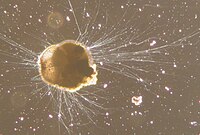| Revision as of 03:01, 30 November 2006 edit70.135.194.142 (talk)No edit summary← Previous edit | Revision as of 03:02, 30 November 2006 edit undo70.135.194.142 (talk)No edit summaryNext edit → | ||
| Line 12: | Line 12: | ||
| ] <br> | ] <br> | ||
| ] <br> | ] <br> | ||
| ] <br> | ] <br> | ||
| ] <br> | ] <br> | ||
| ] | ] | ||
Revision as of 03:02, 30 November 2006
| Rhizaria | |
|---|---|

| |
| Live Ammonia tepida (Rotaliida) | |
| Scientific classification | |
| Domain: | Eukarya |
| Kingdom: | Rhizaria |
| Phyla | |
The Rhizaria are a major line of protists. They vary considerably in form, but for the most part they are amoeboids with filose, reticulose, or microtubule-supported pseudopods. Many produce shells or skeletons, which may be quite complex in structure, and these make up the vast majority of protozoan fossils. Nearly all have mitochondria with tubular cristae. There are three main groups of Rhizaria:
Cercozoa - Various amoebae and flagellates, usually with filose pseudopods and common in soil
Foraminifera - Amoeboids with reticulose pseudopods, common as marine benthos
Radiolaria - Amoeboids with axopods, common as marine plankton
A few other groups may be included in the Cercozoa, but on some trees appear closer to the Foraminifera. These are the Phytomyxea and Ascetosporea, parasites of plants and animals respectively, and the peculiar amoeba Gromia. The different groups of Rhizaria are considered close relatives based mainly on genetic similarities, and have been regarded as an extension of the Cercozoa. The name Rhizaria for the expanded group was introduced by Cavalier-Smith in 2002, who also included the centrohelids and Apusozoa.
References
- Cavalier-Smith, T. (2002). "The phagotrophic origin of eukaryotes and phylogenetic classification of Protozoa". International Journal of Systematic and Evoluionary Microbiology. 52: 297–354.
- Sergey I. Nikolaev; et al. (2004). "The twilight of the Heliozoa and rise of the Rhizaria, an emerging supergroup of amoeboid eukaryotes". Proceedings of the National Academy of Sciences. 101: 8066–8071.
{{cite journal}}: Explicit use of et al. in:|author=(help)